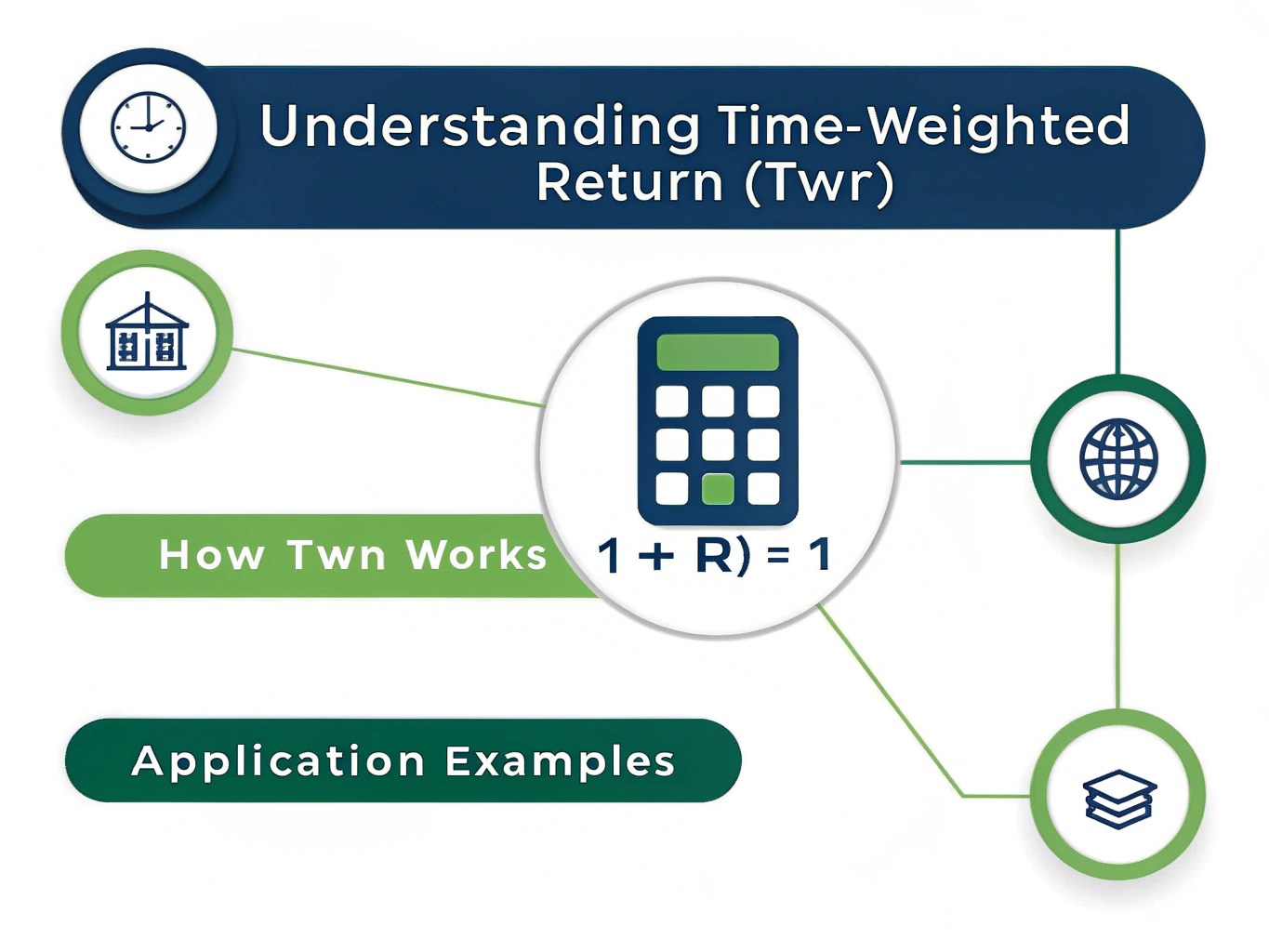Time-Weighted Return Calculator
Is this tool helpful?
How to Use the Time-Weighted Return Calculator Effectively
Follow these simple steps to accurately calculate your investment’s time-weighted return (TWR):
- Step 1: Enter the total number of investment periods you want to analyze, between 1 and 100. For example, if you track monthly returns over six months, enter 6.
- Step 2: Input the return percentage for each period. For instance:
- Period 1: 4.15%
- Period 2: -0.90%
- Period 3: 3.50%
- Period 4: 2.20%
- Step 3: Click the “Calculate TWR” button to obtain the time-weighted return for your investment over the selected periods.
What Is the Time-Weighted Return Calculator and Why Use It?
The Time-Weighted Return Calculator is a tool designed to help you measure your investment performance by eliminating the effects of cash flows, such as deposits or withdrawals. This method focuses purely on the portfolio’s growth rate across multiple periods, providing a fair and unbiased performance metric.
By using this calculator, you can:
- Accurately assess investment returns regardless of cash inflows or outflows.
- Compare different investment strategies fairly.
- Standardize performance measurement for better benchmarking.
- Track portfolio manager effectiveness by isolating returns from client cash movements.
Example: How the Time-Weighted Return Calculator Works
Suppose you want to calculate your investment’s overall performance for four quarters with the following returns:
- Quarter 1: 3.60%
- Quarter 2: -1.25%
- Quarter 3: 2.80%
- Quarter 4: 4.10%
The calculator computes TWR using the geometric linking of each period’s return as:
$$ \text{TWR} = \prod_{i=1}^{n} (1 + R_i) – 1 $$Where:
- ∏ means multiply all period returns together
- n is the number of periods (4 in this case)
- Ri is the return for each period expressed as a decimal
Using the calculator, you enter each period’s return percentage, and it determines the combined growth rate without being skewed by any cash additions or withdrawals during these quarters.
Key Benefits of Using the Time-Weighted Return Calculator
- Removes distortion from external cash flows affecting the portfolio.
- Gives a precise measure of your portfolio manager’s performance.
- Enables fair comparison across different funds and investment approaches.
- Standardizes returns tracking over different time frames.
- Supports benchmark and peer-group performance evaluations.
Practical Uses of the Time-Weighted Return Calculator
Analyzing Portfolio Performance Over Specific Periods
If you monitor your portfolio’s monthly returns for five months, the calculator helps you find the true aggregate performance, ignoring when you added or withdrew money.
Comparing Different Investment Strategies
Use the calculator to fairly compare two or more investment strategies over the same periods. By neutralizing cash flow effects, you get an unbiased view of which strategy performed better.
Real-Life Scenarios Where TWR Calculation Is Essential
1. Evaluating Investment Funds
Funds report their returns using TWR to give investors consistent and fair performance data, regardless of when investors join or leave the fund.
2. Tracking Personal Investment Portfolios
Individual investors use TWR to monitor portfolio growth accurately, especially when they frequently contribute or withdraw funds.
3. Financial Advisor Reporting
Advisors rely on TWR to demonstrate their investment management skills by isolating return performance from client cash flow timing.
Advanced Applications of Time-Weighted Return
Multi-Year Investment Performance
Investors analyzing annual returns over several years can use TWR to understand long-term growth trends, unaffected by capital movements within the periods.
Combining TWR with Risk Metrics
Integrating TWR with risk-adjusted measures offers a fuller picture of your investment’s reward versus risk over time.
Frequently Asked Questions About Time-Weighted Return
What distinguishes TWR from simple returns?
TWR accounts for the timing of cash flows by linking returns geometrically, while simple returns ignore cash flow timing, potentially distorting performance assessment.
When should I prefer TWR over other return calculations?
Use TWR when you want a clear view of portfolio or manager performance unaffected by cash deposits or withdrawals.
Can the time-weighted return be negative?
Yes, if your combined returns result in a net loss across the analyzed periods, the TWR will be negative.
How frequently should I calculate TWR?
Calculate TWR according to your investment review schedule—daily, monthly, quarterly, or annually—to suit your monitoring needs.
Is TWR better than Internal Rate of Return (IRR)?
Each serves different purposes: TWR measures performance independent of cash flows; IRR reflects the investor’s actual return including timing impacts.
Can TWR compare different investment strategies effectively?
Yes, because it excludes cash flows, TWR provides a level playing field for comparing strategy results.
How does TWR manage portfolio rebalancing?
TWR incorporates rebalancing returns like any other period returns, making it a reliable measure for portfolios that rebalance regularly.
Is TWR standard in professional investment management?
TWR is widely accepted in the industry and required by standards like the Global Investment Performance Standards (GIPS) for consistent and transparent reporting.
Important Disclaimer
The calculations, results, and content provided by our tools are not guaranteed to be accurate, complete, or reliable. Users are responsible for verifying and interpreting the results. Our content and tools may contain errors, biases, or inconsistencies. Do not enter personal data, sensitive information, or personally identifiable information in our web forms or tools. Such data entry violates our terms of service and may result in unauthorized disclosure to third parties. We reserve the right to save inputs and outputs from our tools for the purposes of error debugging, bias identification, and performance improvement. External companies providing AI models used in our tools may also save and process data in accordance with their own policies. By using our tools, you consent to this data collection and processing. We reserve the right to limit the usage of our tools based on current usability factors.







